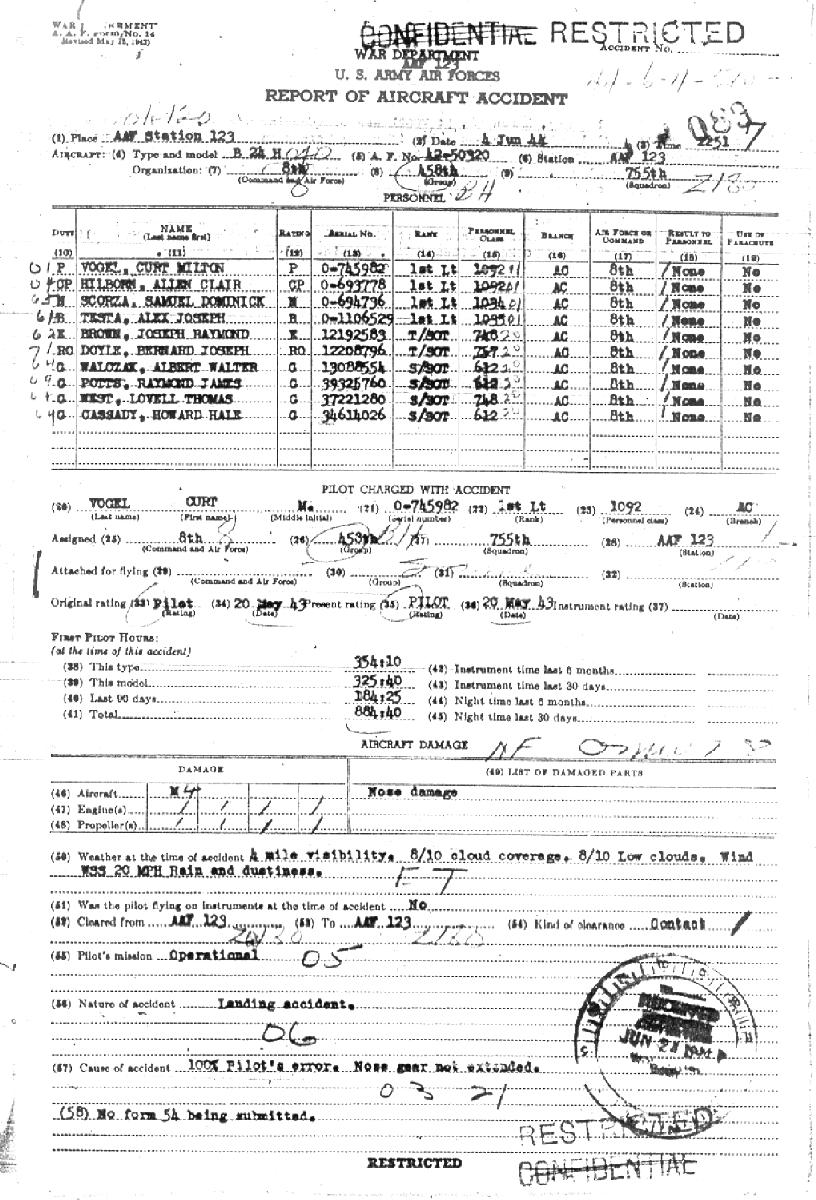458th Bombardment Group (H)
A Navigator’s Diary

Samuel D. Scorza joined the USAAF as an Aviation Cadet on July 21, 1942. He was called up in January 1943 and was sent to San Antonio Aviation Classification Center for classification and training. Although qualified to be a pilot, he was assigned for navigation training.
In June 1943 he was sent to the Army Air Forces Navigation School at San Marcos, Texas where he underwent training (Class 43-14) for the next four months. He was graduated on October 7, 1943, and commissioned as a Second Lieutenant.
In mid-October he was sent to Tonopah, Nevada where he joined the 458th Bombardment Group which had been activated in July and was assigned to Crew 74 in the 755th Squadron. The group trained as a unit and left for the ETO in January 1944.
Unfortunately, he did not record his combat training at Tonopah. His diary picks up with the crew’s first combat mission on March 5, 1944.
Towards the end of his combat tour and the raids on the invasion coast throughout May and early June 1944, he did not have either the time or energy to write about his just completed missions as he had done throughout most of his tour. The entries for his last several missions are sparse or non-existent.
In July 1944, having completed his combat tour, he was sent back to the States on leave, eventually being assigned to as an Administrative Officer in Miami, Florida until the end of the war.
In his footlocker were two diaries. The first with a cover title of My Stretch In The Service, detailed his time during training (up until Phase III Combat Crew Training); and the other details his combat missions. Both are reproduced here. I remember reading these over and over again when I was growing up, trying to imagine what it was like to be him and do the things he described.
I have added images where relevant. Comments in [italics] are mine.
Training
LEAVING HEAVEN FOR HADES
Or
THE CHANGE FROM A CIVILIAN TO AN AVIATION CADET
July 6, 1942
In Chicago’s downtown old post office building, took Aviation Cadet qualifying examination. Passed the examination with a score of 108 correct answers out of 150. 80 was sufficient for passing. Was third highest in a group of 250 applicants.
July 8, 1942
The second step in qualifying required a thorough physical examination, which took from 8:00 AM until 5:00 PM. Passing the physical, I was interviewed by a captain to determine my character and habits. Three letters of recommendation or character references were submitted:
W.H. BOOSTER CITIES SERVICE OIL CO.
A.G. COLLINS WILSON & CO.
T.A. DELANEY GULBRANSEN CO.
July 21, 1942
In a simple ceremony held in the old post office building, I was sworn into the Army as a private, waiting assignment as an Aviation Cadet.
January 14, 1943
After six months of waiting, I finally received my appointment as an Aviation Cadet on January 9th. Severing my connections with the Cities Service Oil Co. as assistant credit manager, and settling other minor affairs and the many good-byes which were said, I was ready to leave for San Antonio, Texas. A number of lectures were given to us before we boarded the special train to travel more than a thousand miles southward. An empty and strange feeling was within me as we rolled farther and farther away from home.
January 16, 1942
After traveling for two days we arrived in San Antonio, Texas at the San Antonio Aviation Classification Center [S.A.A.C.]. Our trip was comfortable — good food and an upper berth. We were taken to the base in my first ride in a G.I. truck and were greeted at the base with cries of “You’ll be sorry!” from the boys already at the base. I was sorry.
January 16 – March 10, 1942
S.A.A.C. – San Antonio, Texas
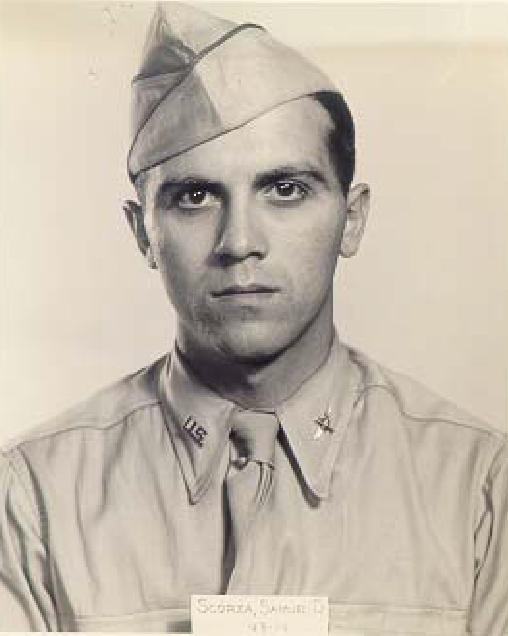
Orienting myself to Army ways was a difficult, trying task; my nature rebelled and caused me some trouble with those in charge. I never did like regimentation, and never will. My first experiences consisted of getting acquainted with the usual Army routine, such as getting up in the “wee” hours of the morning to the tune of a bugle (reville) and trying to dress and meet the roll call formation outside in five minutes flat, while we shivered with cold and listened to the orders of the day.
During the day we made many formations, which usually consisted of mess, P.T., announcements, or the many rock picking up formations, P.W.A. in action.The first week at the S.A.A.C. was occupied solely with written and physical and mechanical exams, which resulted in our disposition. On January 27th, I was assigned for navigation training. I was disappointed, because I wanted to be a pilot. I shouldn’t have proved so apt for navigation in my tests.
During the nine weeks stay we had one day that we were able to leave the post. I spent the day exploring San Antonio with the boys. After my first few weeks at the S.A.A.C., I became tired of the many formations, drill, P.T., guard duty, K.P., Retreat, etc., so I managed to get myself a “gold brick” job – C.Q. (Charge of Quarters). After that I didn’t even get up for reville, ate when I wanted to without waiting, etc.
It was here that I learned to make a bed, handle a map, etc. The daily inspections caused me no end of gigs – I walked two hours as punishment one Sunday afternoon. The only pleasant time of the day was when the mail came in. I kept myself busy and occupied answering the many letters I received.
On March 9th, we packed our things and boarded a train for Ellington Field, Houston, Texas.
March 10 – June 2, 1943
Ellington Field Houston, Texas
We arrived at Ellington Field on March 10th, early in the morning, tired, hungry, and bewildered. After a good breakfast, we were herded together like cattle and finally assigned to quarters at the end of the day. I was weak all day, and came down with the flu and was hospitalized after reporting for sick call several days later. Being in the hospital put me behind the rest of my squad who had already begun classes. With a lot of hard work in the evenings I managed to catch up.
My entire stay at Ellington was wholly spent in classes of every nature. From early morning at reville (5:00AM) until taps (10:00PM) we were continually studying all the time – except on the weekends, and then sometimes we had to use that time to catch up on the work that we fell behind on. Because of our entire devotion to studies, there were no such duties as K.P or guard, etc. Oh, I did walk two hours as punishment one Saturday afternoon when I should have been enjoying the city of Houston.
I was late for reville and late for P.T. in the same week. What a “chicken” outfit this was – morning parades everyday and a big parade on Saturday afternoon in the hot sun, which took hours. Haircuts every week, shoes shined always – and the mud was terrific; not to mention our bunks and place had to be spotless. Friday was G.I. night, a party we all hated. Saturday was the big inspection day. Roscoe Ates, Hollywood comedian, was Commandant of Cadets. Ellington was a good field – the food was excellent, but they were too severe and chicken about our activities and actions.
Some wonderful times were had in the city of Houston. Looking forward to Saturday and Sunday made the weekdays bearable. After nine weeks of intensive studies, I passed all exams and made the grade as far as preflight navigation was concerned. Because the navigation school couldn’t handle us, we were held over at Ellington for three weeks. We had a good time. We went on a hike and lived in the woods for a few days. Just like a vacation in the North Woods. I played my sax a number of times at the chapel and during my wait to go to advanced, I often spent many hours playing the organ. Also played for two Baptist churches in the city of Houston.
June 3 – October 7, 1943
Army Air Forces Navigation School [A.A.F.N.S.] San Marcos, Texas

San Marcos Class 43-14 Echelon Seven: Sam Scorza is in the front row, 4th from left.
Arriving at San Marcos seemed quite an accomplishment. We were at Advanced Navigation School – it was do or die – our last step. The base at San Marcos was located in a beautiful section and the city of San Marcos itself was a beautiful little town. The first thing I noticed was the treatment by our officers – we seemed to be treated like men and not school kids as we were here-to-fore treated. We lived in cheaply constructed huts, latrine outdoors. When we took a shower, we had to wade through mud to get back to our hut, result – feet still dirty. The food wasn’t bad, but wasn’t good either. At one time more than 50% of the cadets were poisoned by food. The hospitals were so full; the huts were used as sick bays. School schedules were stopped for a number of days.
Our schedule at San Marcos was rugged. We did sleep late though – reville at 6:30AM, breakfast at 7:30AM. Clean up for inspection, make bed, etc. and be in class by 8:00AM. The school day was from 8:00AM to 10:00PM with just enough time out to eat meals. On Saturday afternoons and Sundays we were free, providing we didn’t have work to catch up on or a flight scheduled. I had my first plane ride at San Marcos and became acquainted with many things concerning flying and navigation instruments. During the first nine weeks, we learned all we could about D.R. [dead reckoning] navigation in class and put it to the test in the air on many flights. Our grades were taken from numerous exams given us and from our logs and results of ground and flight missions.
The second nine weeks of our 18 weeks was spent learning the mysteries of celestial navigation. After passing D.R. navigation with the highest marks in the class, I was stumped at first with celestial. It didn’t sink in, and we had to cover our material so fast, there was no time for review. It finally came to me after painful studies and concentration. We started flying day night missions. We had to force land in a field at Baton Rouge, Louisiana once and were grounded at Harding Field for five days — what a reprieve and time we had every day and night.
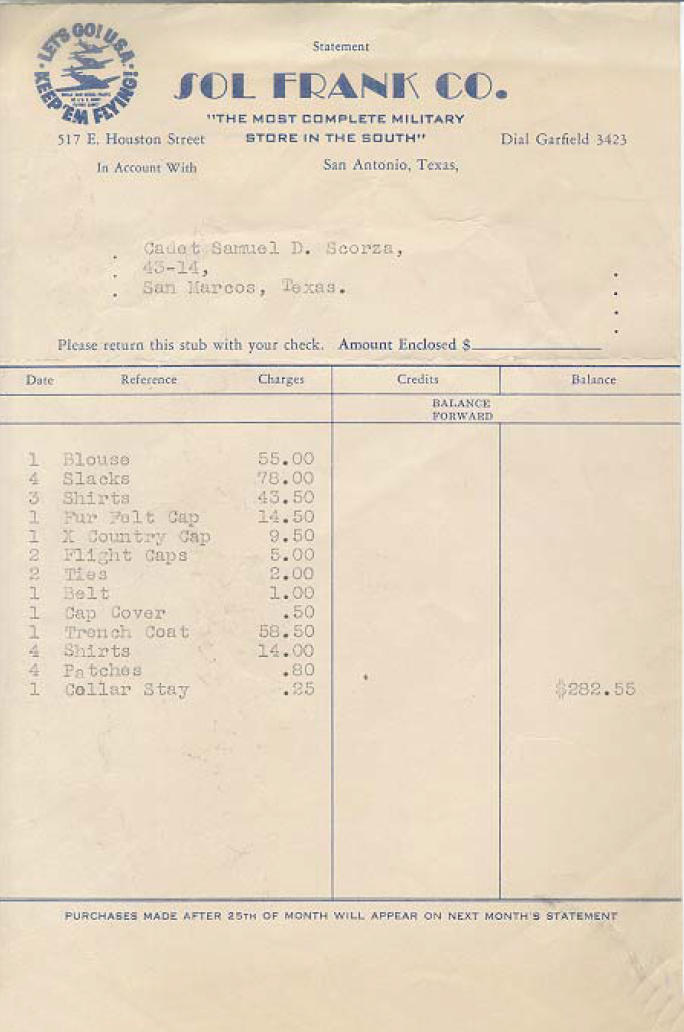
About 50% of our class was washed out and after a struggle, which I wouldn’t care to go through again, I passed all exams, flights, tests of every kind and capacity. Because of our strenuous schedule there was little time for “chicken” treatment – except by the ground officers. Our staff of instructors were swell guys – they were all rated navigators. I was one out of three in the whole class who never flunked a ground mission or a flight mission. I attended Baptist church in San Marcos and played my sax a number of times. Had some good times on the weekends. Preparing for graduation and buying officers uniforms was fun. We had $250.00 to spend and I spent the whole works on my outfit.
The big day came on October 7th when we received our wings and commission as 2nd Lieutenant. The ceremony was impressive with a large audience attending in the base theater. The band played, several speeches were made, and then the final thrilling part when we were sworn in as officers of the United States Army Air Forces. What a day! I felt like a million bucks, and probably acted as such.
In the afternoon we received our money, papers and orders. I was assigned to Boise, Idaho with a ten-day delay enroute. I had a great time going back home with loved ones and enjoying old friends. It sure was good to be home again and how I hated to leave not knowing what faced me in the future. I was afraid as I was alone and had to make new friends and in strange places.
I kinda hated leaving San Marcos with he many friends I had to leave behind me. Although we all worked ourselves to near mental exhaustion, there was something that I liked about the place. Seeing so many better qualified fellows than myself fall by the wayside, I often wondered if I would make the grade and was quite happy and satisfied that my efforts were not in vain.
Combat Tour
Sunday March 5, 1944
We got up at 0330 today for a mission. After four attempts to get in our first mission, today was our real first mission. After a fair breakfast, we reported for briefing at 0415. Our target for today was an airfield three miles East of Bordeaux, France. We carried 12 X 500lbs demo bombs and the usual 5000 rounds of ammunition.
We got off the ground at 0745 and proceeded to form our flight. The various groupings were “snafu” so we tacked onto another group going on the same mission. We left the English Coast at 0930 at 17,000 ft. crossing the French coast at 1006. We reached our first attack of “ack-ack” midway to the target – it was a strange feeling to see the black puffs of smoke a little below us and only a few hundred yards away. Temperature was comfortable – a -22°. We reached the initial point and the purpose of the mission began to take shape. As A.J. was operating the nose turret, it was up to me to release the bombs. So I set up the switches to release the bombs and anxiously awaited sighting the airfield. The moment came at 1152 and with a flick of the finger three tons of demolition bombs went down toward the airfield. The radio operator, watching through open bomb bay doors, noted four of the bombs headed for a cluster of buildings and hangers, soon there was just smoke, fire and debris. Our bombs away we headed for home after circling somewhat away from the target for the other groups. At Cognac, France we received heavy “ack-ack” and too accurate for comfort. It exploded shell after shell along our right and at our level and followed us for eight minutes. Flak seemed to be everywhere. We finally reached the French coast and the English Channel at 1430. No fighters were sighted by our crew, although other crews reported being attacked by FW-190’s and ME-109’s. Plenty of our own escort fighters, mainly P-51’s, P-47’s, and P-38’s were on hand to take care of attacking Jerries.
It was a good feeling to see the English coast again and to soon be on the ground again. After a slight mishap, we landed at 1600. The mishap being some slow-thinking pilot who shot in front of us as we came in for a landing. He changed his mind, gunned his engines, and left us in a heavy prop-wash which momentarily put our ship out of control, so we gunned the throttles and went up and around again for another landing.
The total time in the air was 8 hours and 15 minutes – approximately five hours on oxygen. Altitude 17,000; temp -22°C. Winds from the north at 60 knots. Visibility about five miles – at times complete under cast. Target however was clear. After the various interrogations and evening briefing, I am quite exhausted.
Wednesday March 8, 1944
Target for today was the big one itself, Berlin. Briefing was set for 0600, and after all preparations had been made we took off at 0930 and joined our formation. We carried 16 X 100lb demo bombs and 20 X 70lb incendiary bombs and the usual 5000 rounds of ammunition
Everything went off pretty well. We crossed the Dutch coast about noon and continued on our way to Berlin. It wasn’t until we were deep in Germany until we hit heavy flak, which hit our ship and tore a hole through the tail end of the fuselage. With the heavy fighter support, we didn’t get attacked by fighters. How I love those boys for keeping the fighters away. We saw numerous dogfights, but Jerry was always outnumbered. We cut south of Berlin, made a quick turn north and then west straight over the industrial site on the edge of Berlin. We dropped our bomb load at 1439. The smoke and fires rising from Berlin were tremendous, they could be seen for miles. The whole town of Berlin was visible. Funny thing, all the other large German cities we passed were all covered with smoke screens and Berlin wasn’t, don’t think they expected a raid on Berlin itself.
Some 850 Fortresses and Liberators with a fighter support of 1000 P-47’s, P-38’s, and P-51’s. We headed straight for home, with heavy flak coming up all over and fighters, which were promptly taken care of by our boys. Some 38 of our bombers and 11 of our fighters were lost – to 130 of Germany’s planes. We saw a Liberator go down in flames just before reaching Berlin. Five men parachuted out and three of our P-47’s went down to cover them as they went down. The Lib tore apart in air and crashed in flames in a wooded area near Berlin. [This was most likely Lt Adamson’s crew] We felt swell on reaching the North Sea again after leaving Germany and Holland. We wondered what all the people thought of below as they saw almost 2000 planes go by during the day. The ceiling was quite low over England we came in at 400 feet and landed at 1740.
The total time in flight was 8 hours and 5 minutes. On oxygen 6 hours. Altitude 25,000 feet and temp -37°C. winds from east at 40-60 mph. Our target was really plastered today, a real accomplishment carrying the war to the capital of Berlin itself.
Wednesday March 15,1944
Went to town with Charlie and Dave [Co-pilot and Navigator on Lt. Dunlevie’s Crew] last night and because of an air raid we didn’t get home until 12:30A.M. We were awakened at 0255 for an unexpected mission, which turned out to be Brunswick, Germany. After a pretty good breakfast and several hours of briefing we took off at 0756. Our target was an aircraft manufacturing plant in southwest Brunswick. Our bomb load aboard consisted of 12 X 500lb demo’s and 40 X 70lb incendiaries and 5000 rounds of ammunition
P-47’s went along with us from the channel and over Holland. P-38’s and P-47’s gave us good coverage. when we went through we couldn’t see any German fighters, but there were quite a few during the days operation. We were attacked by flak four times and the hits were very close – close enough to clear part of the paint off of our flying white horse and all that remained was shiny metal and a dent. From our I.P. to the target, flak was very heavy. A.J. was in the turret, and from his signal I released the bomb load on Brunswick. There was an almost complete under cast below, but through a few holes in the clouds I could see fires. Bombing was by P.F.F. Only three bombers were lost on today’s raid and five of our fighters – compared to 36 German fighters shot down. Altitude was at 23,000 feet, temp -40° below.
Tuesday March 21, 1944
The easiest and shortest mission thus far. Our target was a rocket emplacement in Pas de Calais, France. Our bomb load was 4 X 2000lb demo’s. We barely penetrated France, but we really hit flak. Our ship, #441 “Last Card Louie” [B-24H-15-FO 41-52441 J3 I], was hit eight times. We came back between Calais and Dunquerque, could see both cities at the same time also could see White Cliffs of Dover. Altitude was 21,000 feet, temp -25°C, weather rough. My oxygen mask became loose and I got a case of anoxia. I broke the seal on the emergency switch and felt much better. Nearly tossed my cookies. All planes returned safely – no German fighters showed up. We were greeted on the ground by a few dozen ground men as we usually are. They seem to get a kick out of looking for all the holes and damage to the ship. Couldn’t see the bombs drop as I released them as usual.
Thursday March 23, 1944
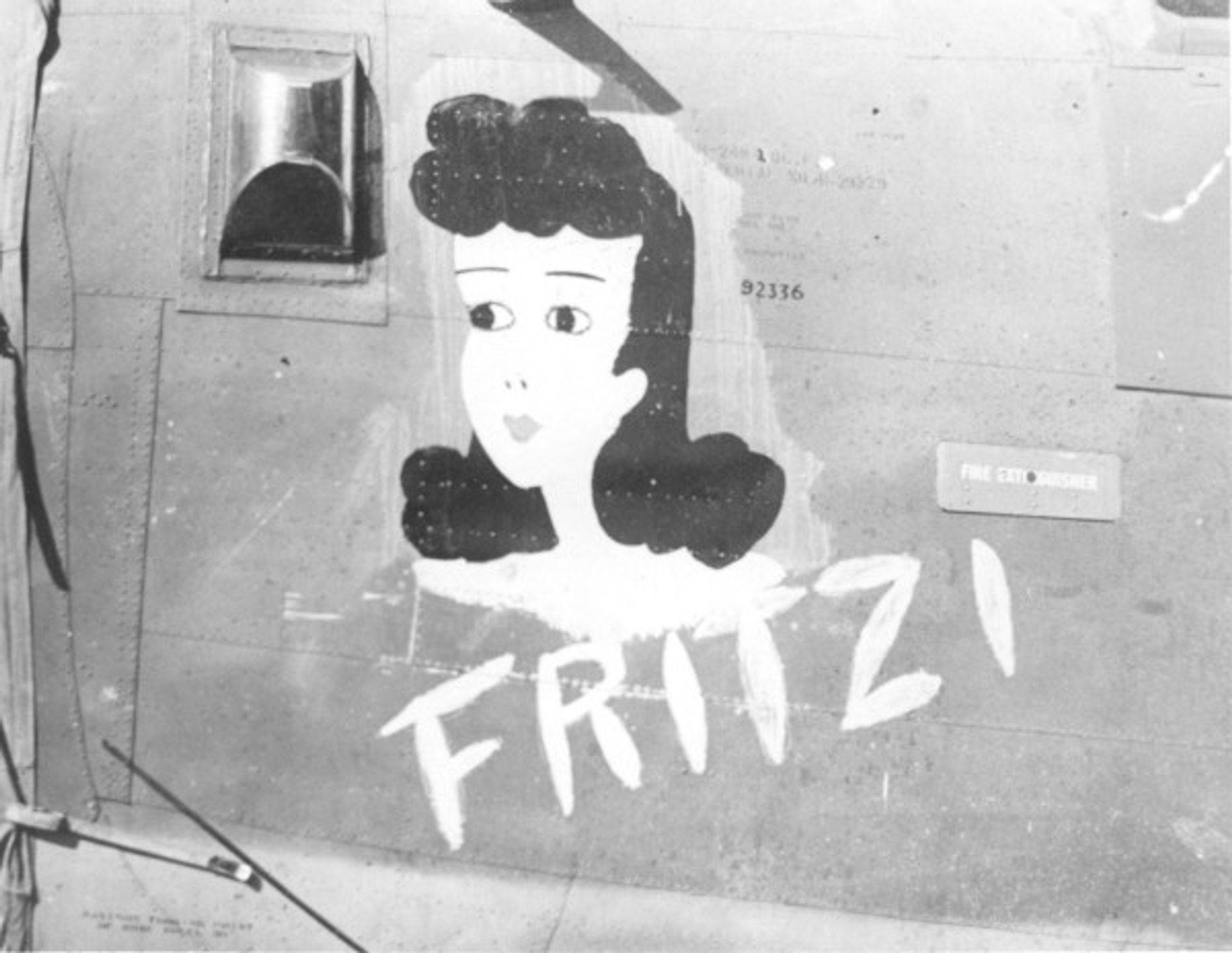
Today’s target was an airfield eight miles northwest of Osnabruck, Germany. Bomb load was 52 X 70lb incendiaries totaling 3640lbs. Again, as in the previous mission, we flew “Last Card Louie”, #441. Altitude was 21,000 feet, temp was -37°C, weather under cast. We were awakened at 0200 for this mission, and after a delay as to determine weather conditions we finally took off at 0700. The bombing was to be by P.F.F. as under cast conditions prevailed all over. Strangely though, the small area around the target was as clear as could be – as though there were a hole in the sky. Our bombs were dropped right on the target. The airfield was completely destroyed.
One of our ships was lost off the target area-a flak hit in the open bomb bays before the bombs were released. The ship exploded. Only one man was seen to jump and he didn’t have his leg straps fastened and slid right out of the chute to his death. Flak was extremely heavy in the vicinity of Osnabruck – kinda had us sweating, especially before we dropped those incendiaries. Upon the completion of this mission we were awarded the Air Medal.
[The ship that was lost was “Fritzi” B-24H-10-CF 41-29329 7V L, flown by F/O Harold W. Hetzler’s crew. All 10 crew members were KIA.]
Friday March 24, 1944
We were quite surprised, and to say the least, very annoyed to be awakened at 0100 when we just went to bed an hour and a half previously and spent that time tossing sleeplessly in bed. I never felt more tired in my life – I felt like a man who was drugged and barely was able to drag my feet along. At first, due to the fact that our bomb load was to be fragmentation bombs, I thought the invasion had begun and we were to spread tons of shrapnel on the Germans.
Our target was an airfield at Metz, France and our secondary target was an airfield at St. Dizier, France. We hit our secondary airfield as the first was completely covered with clouds. The flight itself was rather uneventful except when we crossed the coast of France at Dieppe. We received a volley of flak fire and again at a place about thirty miles inland. That was the only flak or fire of any kind. The Luftwaffe failed to show up, and we had clear sailing. We went to bomb the airfield at Metz, but found under cast conditions – so we altered course and headed for St. Dizier. The field was already under fire as smoke climbed to heights of about a mile or so. We dropped our 240 X 20lb fragmentation bombs – I watched them go all the way down. They dropped on a group of 50 – 75 buildings – that airfield was completely destroyed.
Weather was clear and visibility was good. I wondered how many stray bombs crossed the river to the French town of St. Dizier. The mission took 7 hours of flight and 7 hours of ground preparation. If it wasn’t for the fact that I took a number of aspirin, I don’t know how I would have carried on. We need rest badly, and hope we get it. Altitude was 17,000 feet, temp was -20°C. Bomb load 240 X 20lb fragmentation bombs – 4800lbs all total. Could see Paris and the Eiffel tower on the way to the target.
Sunday March 26, 1944
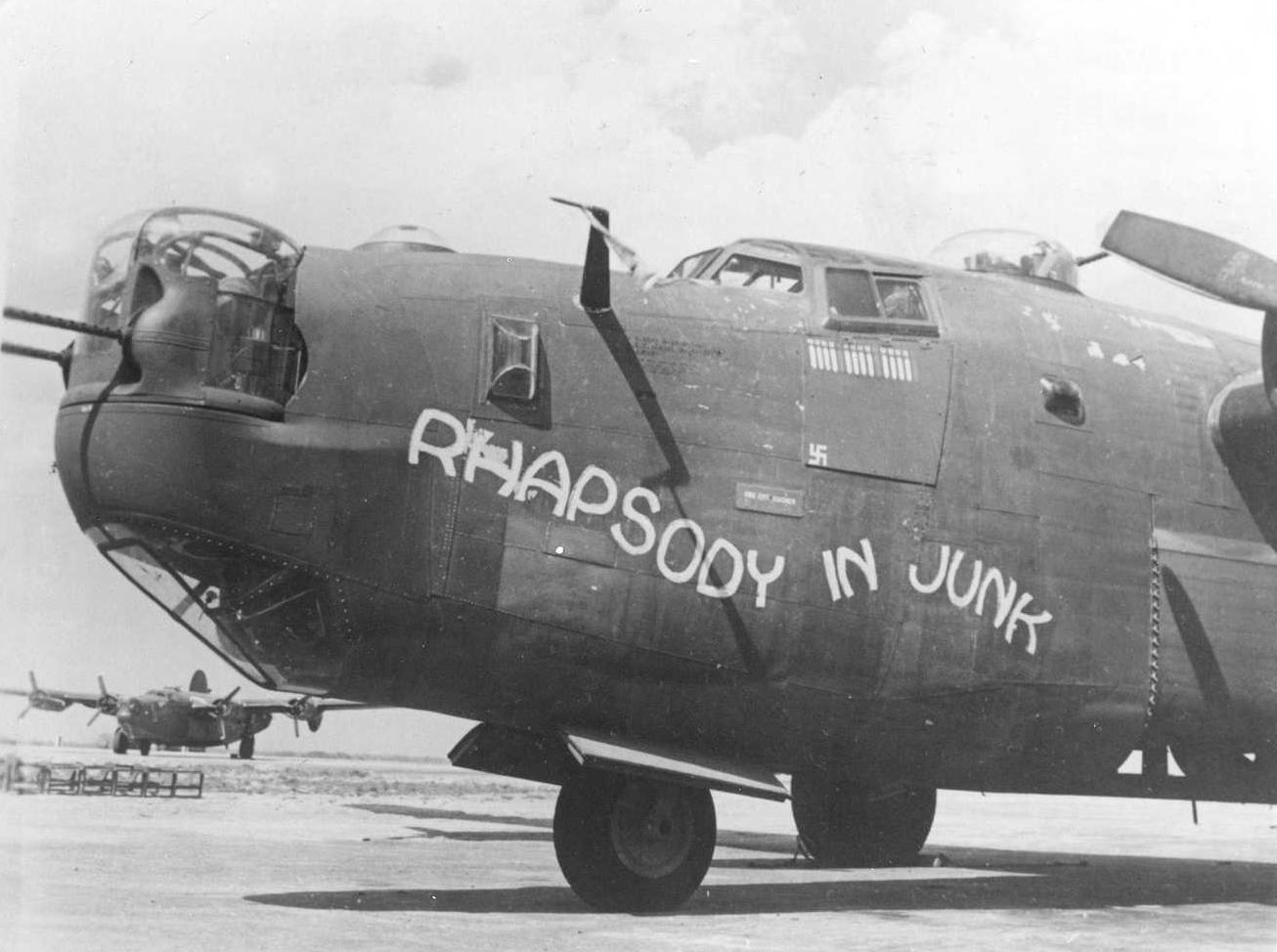
What a waste of effort this day turned out to be. At 0230 we crawled out of bed, had breakfast and went to the briefing hut. We were briefed on what looked like a well planned mission to Oscherschleben, Germany. After making all the preparations for the mission it was scrubbed and we were to stand by for a new mission. After many hours of waiting we were finally briefed on a mission to knock out a rocket emplacement near Ferrent, France.
With a load of 10 X 500lb demo bombs, we took of at 1246. We used a 753rd squadron ship, #733 [B-24H-10-DT 41-28733 J4 P Rhapsody In Junk]. It had the old type super chargers. A few minutes after take off, the terrific pressure from the outside air forced the top hatch open. It hit me on the head and stunned me for a few minutes. It hurt plenty all through the mission, but it’s okay. Whoever was navigating in the lead ship “stunk”. I realized as soon as we left England and crossed the channel that we were far off course and our heading was incorrect. I kept an accurate account of our position and we entered the coast of France about fifty miles south of where we were briefed – instead of the lead navigator correcting north, he continued southeast. To make things worse, we lost one super charger and couldn’t maintain altitude or airspeed for long – we kept [up] as well as we could. By this time, due to being so far from the planned course, we lost our fighter escort. Finally the lead ship must have discovered they were lost and turned on a heading of 330° for home. We crossed the French coast and jettisoned our bombs in the Channel due to super charger trouble – everyone else brought their bombs back. We were fifty miles away from our target. We were okay once we got below 15,000 feet.
Upon landing and return to briefing hut, I never saw so much “brass” waiting for us. Brigadier General, several Colonels, many Lt. Colonels and Majors. They just nosed around and listened in to everyone telling how badly the mission went. It’s a bad name for our group and someone is going to do some sweating. Some 15 hours or more wasted and we were lucky – if it were a longer mission, we would have had to bail out over enemy territory. Then too, it’s a good thing no enemy fighters were around, or we really would have had a battle. Altitude was 20,000 feet. Temp -20°C. Bomb load, 10 X 500lb demo’s totaling 5000 lbs.
[Due to his head injury, my father spent several days in the hospital after this mission. During that time, his crew flew two missions with a replacement navigator. When most of the crew completed their tour on June 5, 1944, my father flew the next two days, June 6 and 7 to complete his tour.]
Wednesday April 5, 1944
After a stand-down on Tuesday, we were alerted at the late hour of 0100, our wing [96CBW] being the only operation of the day. The mission was uneventful, very little flak was seen, but weather was so bad it was more dangerous than Germany’s flak. It prevented us from bombing (complete under cast) and the let down through the clouds was hazardous. How all planes got down without a collision is short of a miracle. Even the Colonel [James H. Isbell, 458th C.O.] was quite worried. Again we went to the Pas de Calais area, target which wasn’t exactly described, but thought to be an invasion stronghold of defense. We took off in bad weather at 1035 and landed at 1420.
Saturday April 8, 1944
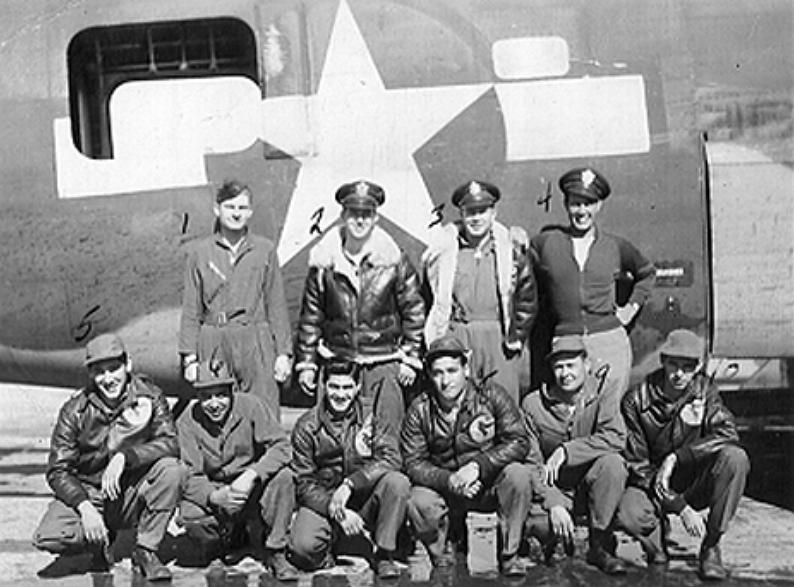
This day was an eventful one and one long to be remembered. At 0500 we were awakened for a briefing at 0620. Again at 0545 I received another message that I was to be at group operations for a pre-briefing at 0520. Thinking it too late for the pre-briefing, I started for the regular briefing and stopped for breakfast on the way. I had just finished eating when I was paged and off we went in a jeep to group operations. The staff left, so I went over to briefing. Colonel Fielding called me and I reported to a captain who was waiting with a jeep. He said the colonel was waiting for me in a command car and that we were going to Hethel field for a pathfinder ship. I quickly gathered my flying clothes and navigation equipment and the captain drove me over to where Colonel Isbell and Major Jamison [755th Squadron C.O.] were waiting in a command car. We had a half hour to cover the nine miles to Hethel, so our driver really burned up the roads. At Hethel we were briefed on the mission. As I was preparing my flight plan I wondered who was looking over my shoulder and almost died when I found out it was a brigadier general. The small room we were in was full of big brass and me only a lowly lieutenant.
Our target was an airfield about two miles north of Brunswick. This was a new experience for me as I was selected to be in the lead ship which was leading the entire 96th Combat Wing. Lt. Locke [389BG lead crew, pictured left] was pilot, Col. Isbell was command pilot, Lt. Reed was DR and Gee navigator, another Lt. was a radar or pathfinder navigator and my job was to do pilotage navigation. Col. Isbell kiddingly promised me a swift kick in the pants if we missed our target. We took off at 1000hrs and proceeded to Horsham and buzzed the field several times at 100 feet.
We then proceeded to assemble with all the groups and left the coast of England at 1202. We crossed the coast of Holland at 1239 and proceeded on course. Heavy flak was coming up from Quakenbruk, Osnabruck, Hannover and other towns along the route. Then as we approached the wing I.P. enemy fighters – ME-109’s by the hundreds were seen attacking our ships. As many as four Lib’s at a time were seen to go down – which made us all sick. Our own fighter support wasn’t enough to take care of the Germans as they weren’t in the vicinity of the target when we received the brunt of the attack. Our bombs were dropped on the airfield at 1516 and we really hit and smashed the airfield – but good.
We had to battle our way all the way home as excessive heavy flak was being shot at us coming too close for comfort. ME-109’s kept picking off one ship at a time, jumping on those that were easiest to get. The enemy fighters followed us all the way to the channel. Many dogfights could be seen with our own P-38’s, P-47’s, and P-51’s with the ME-109’s. Many crippled ships could also be seen flying over the channel back home. It was surprising to see our own fighters come seemingly out of nowhere in reply to a distress signal from one Lib. The English coast never looked better as we crossed it and proceeded for Hethel and landed at 1700. The colonel left the plane immediately and sent a car after me. The rest of the crew went back together on a truck. I felt quite important riding in the command car alone and thankful to the colonel for thinking about me.
We were interrogated by Hethel’s intelligence officers and we were picked up by our car and driven back to Horsham. The boys in the Pathfinder ship patted me on the back and complimented me many times on the nice job of navigating. They wanted me to join their crew. It was a good job of navigating for we were always on course and hit our target dead on. Of course the weather was good, which was a helpful factor. Battle damage to our ship was mainly a large hole in the wing and numerous smaller holes in the fuselage. After all the missions we have been on without seeing a single German fighter – it was surprising to see the Luftwaffe up in such great numbers. We weren’t prepared for it and I believe our own fighter support was outnumbered. The German radio claimed they stopped us from going to Berlin. That’s a lot of “poppycock”, we went to our target with no deviation or altering of our briefed mission.
I can’t help but feel somewhat proud of the fact that I had so important of a part to play as lead navigator in the lead ship – leading some 100 or more airplanes to the target. The responsibility was resting heavily on my shoulders, but I trusted in the Lord for help and I know He was with me. It’s a wonderful feeling of accomplishment to fill so important a position. At least we didn’t take them to Switzerland like they did last Saturday. This was by far the toughest and eventful mission so far. We were fortunate in our group. Out of thirty ships we lost only one, Sievers crew. Lt. Sievers, Lt. Driver, Lt. Dayson, and Lt. Slaughter were in that crew. One boy from another ship [Sgt. John W. Kirby, 752nd] was shot up in his legs and died late tonight in the hospital.
Monday April 10, 1944
Today’s mission was to bomb an aircraft factory near Bourges, France and we did just that. I had a good view of the target area before bombs fell – then I saw the bombs hit their marks – buildings, planes, and everything was going up. Before the bombing started, I counted 75 planes dispersed on the ground – some which were four engine jobs. The smoke towering some 5000 feet could be seen for 65 miles. Mission otherwise was uneventful, little or no flak and no fighters came close enough for us to see them.
Tuesday April 11, 1944
Feeling low and weak, today’s mission was a hard one physically. For the first time I was ready to drop my cookies, but I fought it off. It’s a tough job when you’re under oxygen and your stomach is all topsy-turvy. Our 1000lb bombs fell squarely on the aircraft factory at Oschersleben. Flak was extremely heavy – we escaped with only a few hits and light damage to our ship. I watched many boys going down in chutes today. I especially had a good view of one and followed him down to about 1000 feet then I saw them open fire on him with machine guns probably. I was praying for the poor helpless guy floating slowly to earth. Then as he passed over another place he was fired at again. I was enraged and angry – I was wishing we had more bombs left to go over and bomb them to Kingdom Come.
We lost an engine while still over Germany and slowly fell from the formation. When we reached Holland and the channel we were alone, except for another Lib that wanted to stay with us in case of attack or going down in the water. We were all set for ditching the plane. I had the radio operator break radio silence and send SOS messages every ten minutes with our position. I left my navigation and stood by on the flight deck near the radio operator. I navigated in my head – we were just a little south of the field when we made landfall. I felt good about that. Land was beautiful to see – we cancelled our SOS and shot red distress signal flares and landed immediately. Really sweated this one out – thought it was our last.
Thursday April 13, 1944
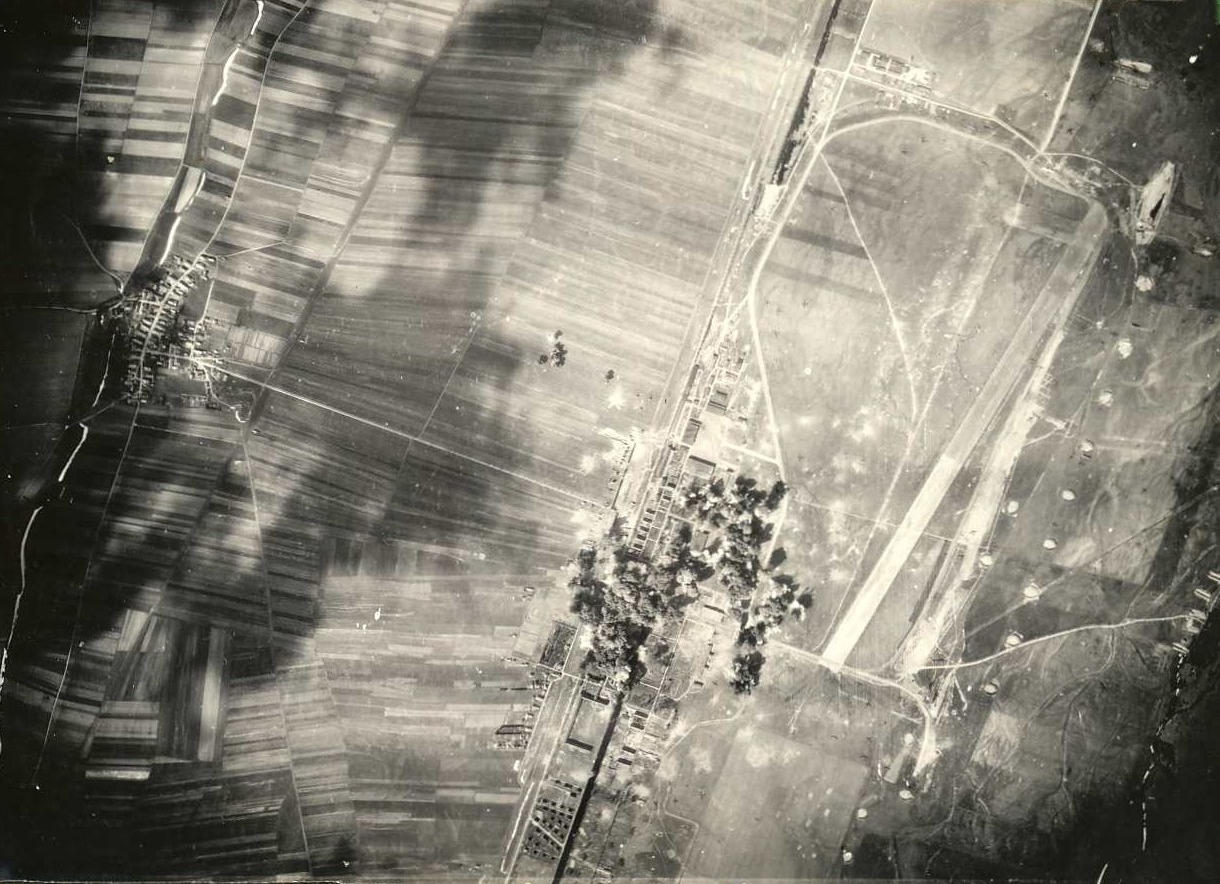
Long one today – eight hours in the air. we went deep into southern Germany. As for a sight-seeing trip, saw many large cites and countries such as, Belgium, France, Luxembourg, Germany and the town of Konstag and the Lake Constance could be seen of Switzerland. Saw Brussels in Belgium, the Rhine River and many other geographic points. Our load of bombs was 12 X 500lb demos. Not much flak was encountered nor any enemy fighters came close, but the towering cumulus clouds made formation flying more dangerous than flak or enemy fighters. The weather was clear over the target and again I had a good view of the area before bombs even fell. Some fifty planes were on the field and the first group of bombs fell inside and to the left, but our two sections bombs fell directly at the buildings, which was our M.P.I. – a beautiful job. The field and buildings must have been completely destroyed. The airfield [Lechfeld A/F] was ten miles south of Augsburg, Germany. We landed short on gas. We had about a twenty minute supply left.
Wednesday April 19, 1944
After spending a two-day leave in London, I returned late last night to find I was on the alert. Went to bed at 0100 and was awakened at 0300. During those two hours of sleep we had two air raid alerts, which interrupted what little sleep I could have had. Our mission today was to bomb an airfield at Paderborn, Germany. Our group led the division. Again, fighters chose not to come near our formation and flak was very meager. With a clear day and all possible conditions – the bombardier missed the target. A perfect mission, if only we had hit that target.
Thursday April 20, 1944
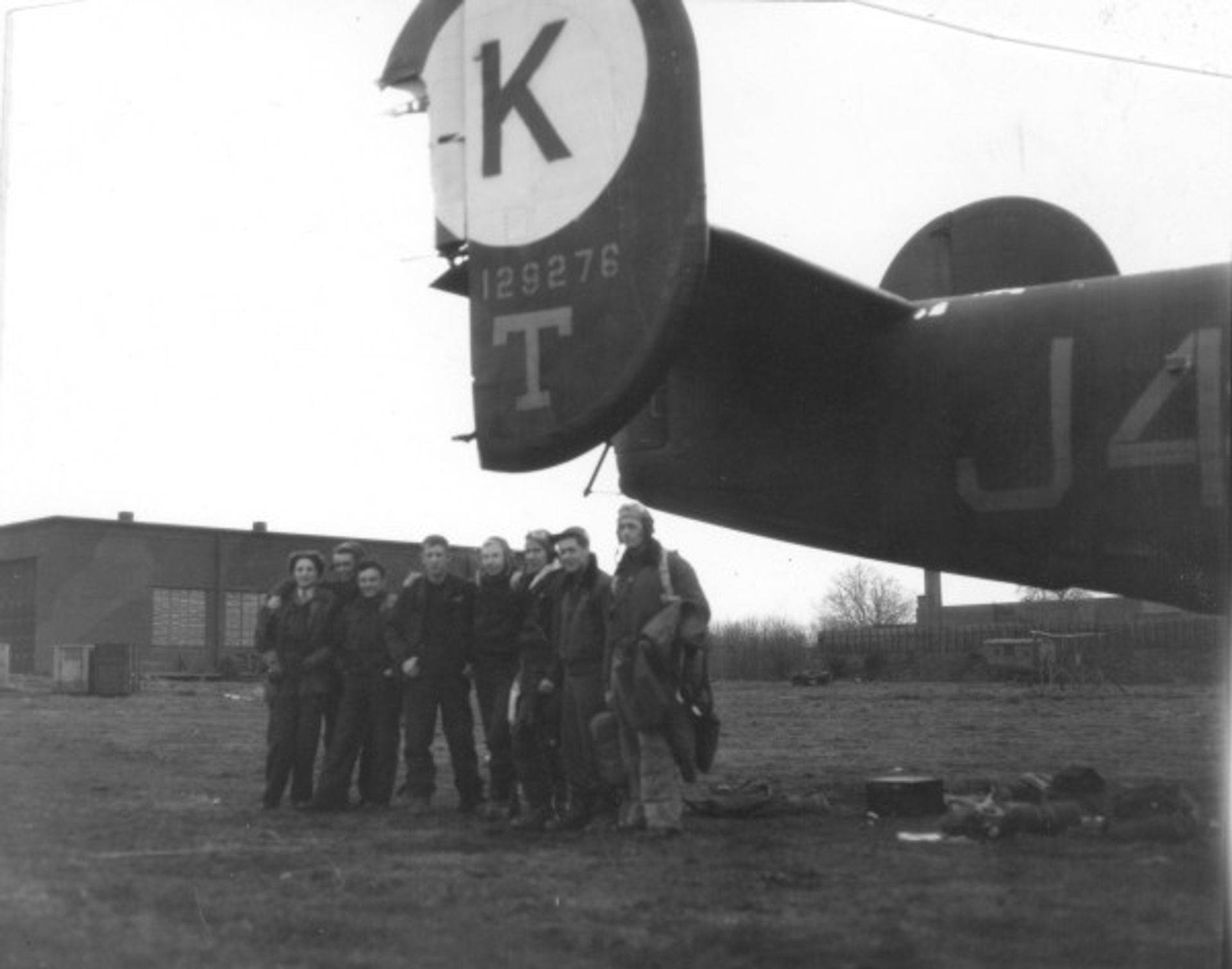
We operated on a different schedule today, taking off at 1600 and returning to base at 2030. Our target was a military installation near Pao, France in the Pas de Calais area. We entered the coast of France about three miles north of Dieppe where we received our first flak – one of our ships piloted by Manker was hit and he returned to England and crash landed. Three bailed out – it is believed the crew is all okay.
[This crew actually landed at RAF West Malling]
Our greatest barrage of flak and rocket fire was received from Abbeville while we were on the bomb run. A plane was hit square in front of us and blew up. Five men were seen to bail out. We made our way to Belgium and left the Continent. The Germans got the jitters with 2000 of our planes raiding the invasion coast until dark. They sent reconnaissance bombers over every hour last night as they thought the invasion was taking place. It sure looks like everything is pointing to the invasion, but it will in all probability be several weeks yet.
Saturday April 22, 1944

Our 15th mission, and our most unusual mission thus far. We get a seven day rest leave after this mission and we really need it. We took off at 1645 with 10 X 500lb demo bombs to bomb our target at Hamm, Germany – railroad yards – which is the largest RR yards in Germany – carrying all manufacturing product from the Ruhr. We met with the usual heavy flak, but no enemy fighters. We planted our bombs “smack-dab” on the target and noticed other targets that were really hit too. Such cities as Muenster and others. We got off course coming home and it was getting dark while reaching the coast of Belgium. We received a display of fireworks from rocket guns below, which was quite a scene to see. It became dark before we reached the English coast.
We proceeded to our base when I noticed what I at first thought to be an English Mosquito flying through our formation. He was shooting at us and missed by a few yards. A.J. could have shot him down had he known it was a Jerry. After a few seconds, he was shooting at another plane and one engine exploded and the plane was hurtling earthward, a mass of flames. Somehow the signals were crossed and an alert was given on the ground and we were immediately under fire from English ack-ack and we at low altitude. We took off for the North Sea and tried to make contact with the field, which was under attack by German fighters who followed us home. After a hectic time we finally made our way back to the field and by God’s grace and mercy we found it and landed at 2130.
We were all nervous wrecks. Interrogation was brief. We ate and saw a movie rather than go to bed as we were too excited to sleep. Finally went to bed at 0330. It was discovered the next day that some gunners from another crew that wasn’t flying held an English ack-ack battery from firing at the point of pistols. A never to be forgotten mission. Our division lost ten planes over Germany and seventeen planes over our own bases.
[One German Me410, flown by Oberleutnant Klaus Kruger was credited destroyed by Sgt Lewis Brumble 755BS]
Thursday May 4, 1944
Took off at 0700 with 6 X 1000lb demo’s to be dropped on Waggum airfield, Brunswick, Germany. The mission was recalled just as we crossed over Holland and into Germany. No flak, no fighters, no bombs dropped.
Sunday May 7, 1944
Took off at 0700 for Osnabruck, Germany with 12 X 500lb demos to be dropped on the marshaling yards. Complete under cast, bombs were dropped by P.F.F. Heavy flak, but no fighters. Very cold, -38°C. Landed at 1130.
Monday May 8, 1944
Before we even took off we were scared stiff. About four planes crashed on takeoff due to heavy frost on the wings. The sky was filled with smoke towering several thousand feet. We shot off a red flare on take off, taxied around and cleaned our wings off again. Took off and returned again because a gas cap was loose and the gas was siphoning out. We filled up with gas and took off a second time and tried to catch up with the formation. We noted one plane that crashed – several homes were demolished – nothing left of the plane. Our target was the airfield three miles north of Brunswick. Fighters were fighting us in the target area. I watched numerous dogfights and saw three planes go down in flames. Our tail gunner saw eleven B-17’s go down. About forty ME-109’s headed for our formation, but turned suddenly and made an attack on the B-17 formation. Three fighters made a pass at us on the bomb run, one hit in the nose turret – no one hurt. The Grace of God is what brought us back from this mission. It was really rough.
[While planes from nearby group’s may have crashed, only one plane from the 458BG crashed shortly after take off. Lt Paul Kingsley and crew from the 754BS]
Tuesday May 9, 1944

Very good bombing today, hit an airfield at St. Trond, Belgium right on the button. A GEE box was just installed in our ship, so I amused myself with it and the mission seemed to go faster. This was a good mission, not too cold, flak meager and inaccurate, fighters, but not near us.
[GEE was a radio navigation system used by the Royal Air Force during World War II. It measured the time delay between two radio signals to produce a fix, with accuracy on the order of a few hundred metres at ranges up to about 350 miles (560 km). It was the first hyperbolic navigation system to be used operationally, entering service with RAF Bomber Command in 1942.]
Friday May 12, 1944
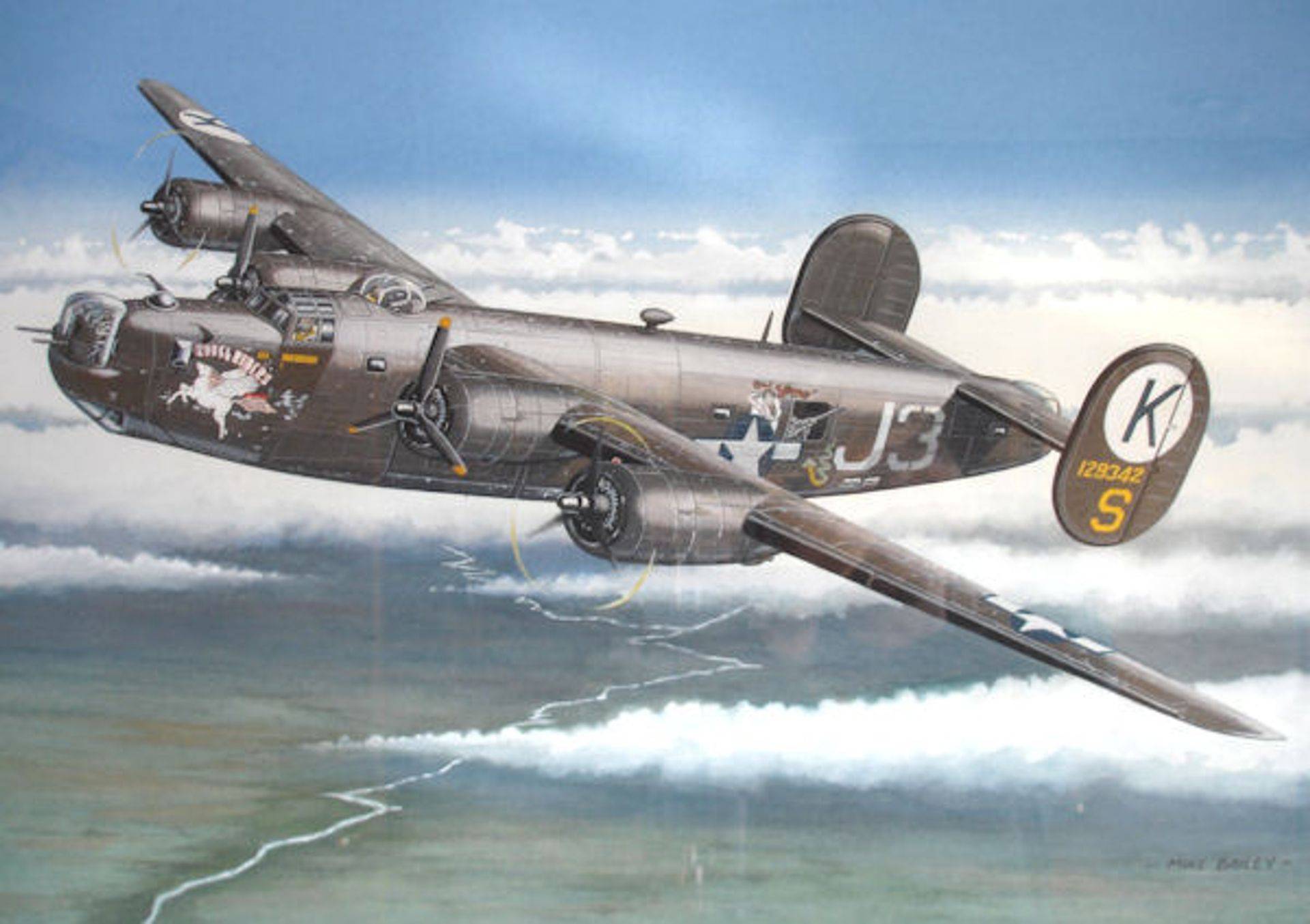
Oil refinery – Leipzig, Germany. Lost two engines via Frankfurt. Returned.
[This is actually one of the more interesting, if cryptic, entries in the whole diary. It was on this date that the crew was lucky to have made it back. The painting by Mike Bailey, pictures B-24H-15-CF 41-29342 J3 S Rough Riders turning back with two engines feathered and a third losing power. When asked by the pilot, which was closer, Switzerland or England, the navigator told them England. After jettisoning all excess weight into the Channel, the crew made an emergency landing at Manston. The rest of the crew accused my father of having a date that night as the reason for not going to Switzerland. Co-pilot Al Hilborn related to me that he did indeed have a date and that he kept it.]
Saturday May 13, 1944
Airfield, Demmin, Germany. Saw attack.
Sunday May 21, 1944
Airfield near Bourges, France
Tuesday May 23, 1944
St. Pol, France
Wednesday May 24, 1944
Paris, France
Wednesday May 31, 1944
Bertrix, Belgium [Marshalling Yards]
Friday June 2, 1944
Invasion coast. Le Tourquet, France
Sunday June 4, 1944
Airfield, Bourges. Six hours. Take off 1550 Landed 2250.
Cracked up on landing. Left formation at coast, chutes over channel, bad weather, night landing.
27th mission.
[B-24H-20-CF 42-50320 J4 J Nose wheel collapsed on landing. Full Accident Report 44-6-4-510]
Monday June 5, 1944
[Target was Stella Plague, France – Coastal areas. Crew 74 completes their 30-mission tour, my dad has two to go.]
Standing:
1Lt Sam Scorza – Navigator
Capt Curt Vogel – Pilot
1Lt Al Hilborn – Co-pilot
1Lt A.J. Testa – Bombardier
Kneeling:
S/Sgt Al Walczak – Waist Gunner
T/Sgt Bernie Doyle – Radio Operator
T/Sgt Joe Brown – Flight Engineer
S/Sgt Ray Potts – Ball Turret Gunner
S/Sgt Lovell West – Tail Turret Gunner
Tuesday June 6, 1944
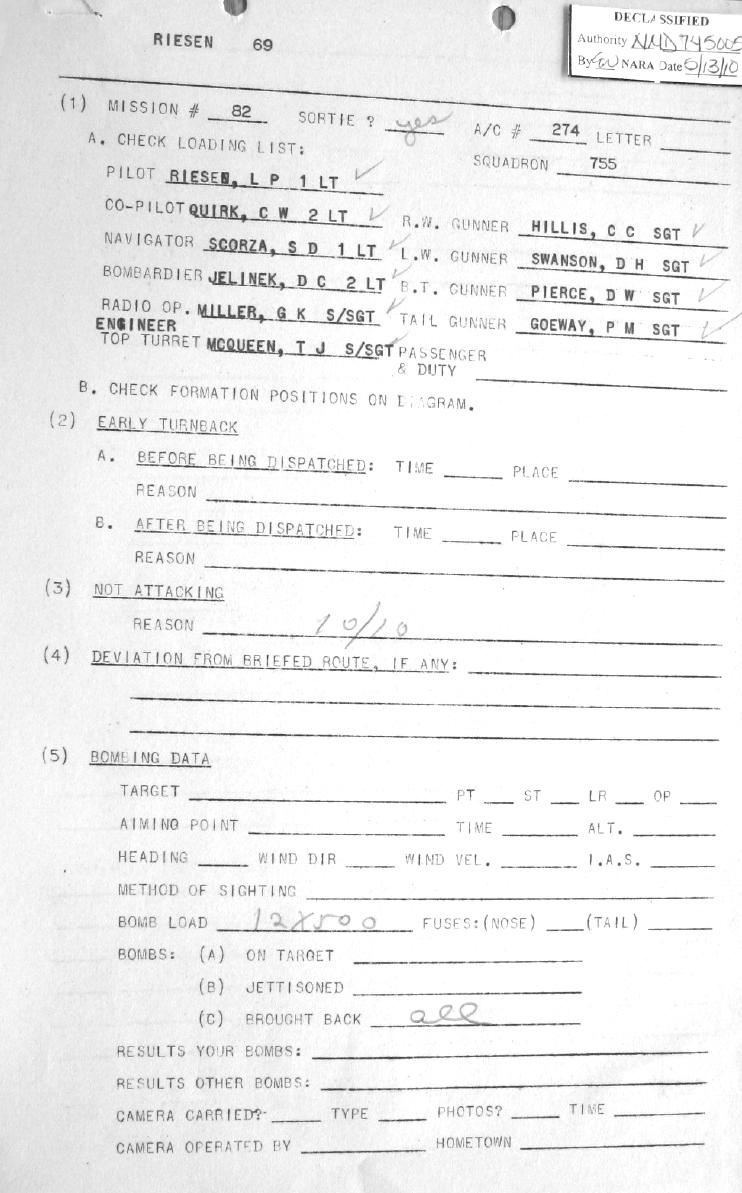
No entry.
D-Day: He flew the group’s second of three missions.
Pilot: Lt Lawrence Riesen.
Target was Villers Bocage, France
Navigation Log shows “10/10 cloud. No bombs dropped.”

